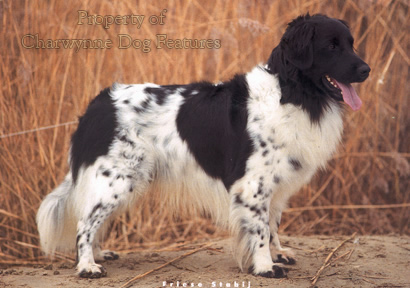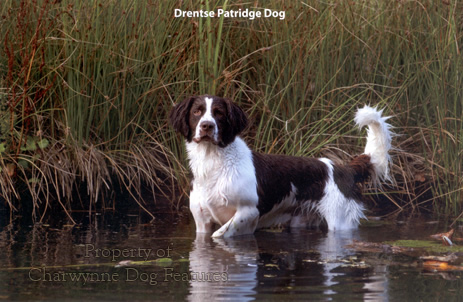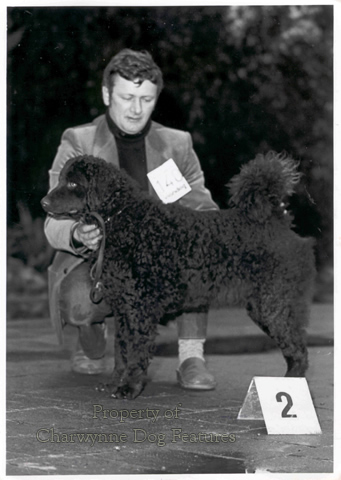8 REGARDING DUTCH GUNDOGS
REGARDING DUTCH GUNDOGS
by David Hancock
 Dutch gundogs, in many ways, reflect their country, a land with a long history of dealing with water. Whilst German gundogs are now well established in Britain and Italian, French and Hungarian breeds have made their mark too, the admirably workmanlike, more modest, relatively unsung gundog breeds from Holland are almost unknown here. This is despite the long association between sportsmen in our eastern counties and those of northern Holland. Friesland too is well known to cattle breeders but the gundogs from there are little known to potential users here. Water-dogs and decoy-dogs were undoubtedly traded between the Frisian Islands and East Anglia for centuries, influencing our now extinct red decoy dog and English Water Spaniel. The Dutch have retained their water dog and their decoy dog and shame on us for not doing likewise. The Kennel Club has recently recognised the American Water Spaniel but offer no incentives for a re-creation of our lost water spaniel, despite it once being recognised by them.
Dutch gundogs, in many ways, reflect their country, a land with a long history of dealing with water. Whilst German gundogs are now well established in Britain and Italian, French and Hungarian breeds have made their mark too, the admirably workmanlike, more modest, relatively unsung gundog breeds from Holland are almost unknown here. This is despite the long association between sportsmen in our eastern counties and those of northern Holland. Friesland too is well known to cattle breeders but the gundogs from there are little known to potential users here. Water-dogs and decoy-dogs were undoubtedly traded between the Frisian Islands and East Anglia for centuries, influencing our now extinct red decoy dog and English Water Spaniel. The Dutch have retained their water dog and their decoy dog and shame on us for not doing likewise. The Kennel Club has recently recognised the American Water Spaniel but offer no incentives for a re-creation of our lost water spaniel, despite it once being recognised by them.
If you asked the average British sportsman if he knew of the Stabyhoun, the Drentse Patrijshond, the Kooikerhondje and the Wetterhoun, you would probably get a blank stare. Their other names give clues as to their origins: Frisian Pointing Dog, Partridge Dog from Drenthe Province, Dutch Decoy Dog and Frisian Water Dog respectively. They are unspoiled breeds, unfashionable but unexaggerated - favoured mainly by true devotees of each breed, rather than fickle sportsmen or show fanciers, ever ready to move on to the next 'breed of the day'. Bred for robustness and performance, not show points or flashy coats, they are not breeds for show-offs or followers of the latest trend. Even when living on the Dutch/German border, I found it hard to get news of them. But a Dutch Decoy Dog has been working at the Boarstall Wild Duck Decoy at Brill near Aylesbury, under Jim Worgan.
The Drentsche Partridge Dog is 55 to 63 cms high (about the size of a whiptail) and white with brown or orange patches, a most handsome gundog. A bigger dog is tolerated in the breed if the symmetry is there. It looks like a miniature English Setter or Small Munsterlander. It was developed to hunt the country of the small Dutch province whose name it bears, rough terrain with plenty of heather and tall grass, often fenced by dense wooded banks. The breed is prized for its calm temperament, strong desire for work and especially for its tracking ability in an area where game could be lost too easily. It is believed to have developed from the European group of gundogs known variously as the epagneul in France, the spaniel in Britain and the spanjoel or spioen in the Low Countries. It is a pointer-retriever in modern terms.
The Frisian Pointing Dog is a little smaller, at around 53 cms high (a shade bigger than our springer) and in appearance resembles a long-haired parti-coloured small setter. Also known as the Stabyhoun, they were often interbred with the Frisian Water Dog and used as mole-hunters and polecat eradicators. Some fanciers promoted the black-headed versions, as did some Munsterlander breeders, but the Water Dog influence, seen in the curly tail, is discouraged. A wavy coat is accepted but a curly one found objectionable by the current breed club. The depiction of these dogs in old Dutch paintings leads to their being identified by 'art experts' here as English Setters or Springers, much to the fury of patriotic more knowledgeable Dutch authorities. This is an attractive fussless breed, unspoiled by modern trends, such as exaggerated coats and over-angulated hindlegs.
The Frisian Water Dog is of a type found all over Europe in past times, including Britain. Our English Water Spaniel, once listed by the Kennel Club, now lost to us, but easily restored if ever we regain our national pride, was in this mould. The Portuguese, the Spanish, the Italians, the French and the Americans have retained and treasured their water-dogs; we have, in our reckless pursuit of all things foreign, forsaken ours. The Frisian Water Dog, or Wetterhoun, is a curly-coated, solid black or brown or part-coloured two-foot high dog, rather like a smaller Curly-coated Retriever. As their name suggests they excel in water, and are robust working dogs, rather than ornamental pets. Over 40 Spanish, Portuguese and Italian Water Dogs are newly registered with our KC each year, over 120 pups; our Curly-coats average around 80 a year.
The Kooikerhondje or Dutch Decoy Dog is being used and shown here, and, with the Canadian breed, the Nova Scotia Duck Tolling Retriever, represents the only surviving decoy breeds in the world. We could so easily have retained our own Red Decoy Dog but were more intent on favouring overseas breeds, and, to be fair, improving them so that they became world-famous. Dutch sportsmen do of course use the superlative gundog breeds we have developed but have had the wit and national interest to preserve their own at the same time. Perhaps now we can promote our own native breeds of gundog, like the Curly-coated Retriever, the Field Spaniel and the Sussex. They are part of our sporting heritage and thoroughly merit our support. The Dutch have certainly shown us the way; as gene pools reveal more and more innate deficiencies, trapped as they are in the pursuit of breed purity, the blood of these Dutch gundog breeds may well have value in strengthening our stock too.